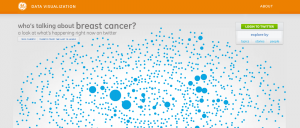 According with the latest Nielsen Social Media Report (Q3 – 2011), females make up the majority of visitors to social networks and blogs, and people aged 18-34 have the highest concentration of visitors among all age groups. Americans aged 35-49 are also avid visitors: 4 percent more likely than average to visit social networks and blogs than they do any other site and 27 percent of these sites’ audience.
According with the latest Nielsen Social Media Report (Q3 – 2011), females make up the majority of visitors to social networks and blogs, and people aged 18-34 have the highest concentration of visitors among all age groups. Americans aged 35-49 are also avid visitors: 4 percent more likely than average to visit social networks and blogs than they do any other site and 27 percent of these sites’ audience.
According to the survey, more women view video on Social Networks, but men watch longer.
Females spend more time than males on social media sites according to Pew Research Center. They also contribute more, use mobile social networking more and they buy more stuff online than men do. More women than men use Facebook and Twitter regularly. They perform Facebook status and profile updates more regularly, comment more, add more photos and click the Like button more than men. If it were not for the constant feminine energy fueling Facebook on a daily basis, the site would be dead.

Men and women are equally likely to have internet access: 73% of men and 75% of women go online. However, in a familiar pattern, women continue to pull ahead when it comes to pursuing health information online:3 86% of online women do so, compared with 73% of online men according to a Pew Survey.
According to Chief Marketer, 47% of women search for coupons and promotions online, whereas there are only 33% of men are looking for such discounts online. Another interesting statistics is that they found men (36%) are more inclined than women (28%) towards finding information about a product while interacting with a retail brand through social media.
Shopper Centric (a website that analyzes shopping behaviors and trends) conducted a research on 1,000 people, which helped in giving a general insight on how men and women use social media for online shopping. According to them, 38% men use a smartphone as opposed to 29% if women; 60% of women use Facebook actively as compared to 52% men.
According to a report by ComScore, “Women on the Web”:
•Average time spent online by men is 22.9 hrs, whereas women spend 24.8 hours.
•Women spent an average of 16.3% of their online time on social networks in April 2010, compared to 11.7% of men.
•When it comes to Twitter, men mostly post their own tweets, whereas a larger percentage of women users use Twitter to find deals and promotions. Women are more likely to use this service as a conversation medium and to follow celebrities.
•Women surpass men when it comes to the reach and time spent on photo-sharing sites.
•The number of visits on retail websites is more or less the same for both the genders for all age groups, but women tend to spend more time on these websites than that of men.
•On an average, men conduct more searches per searcher then women (71.6% per searcher for men vs. 64.0 for women).
Most women use Facebook to keep their friends informed about what they are doing, but few have tolerance for friends who use the site to brag or over-share, according to a survey from Eversave that also explores group-buying preferences among women.
Despite such occasional annoyances, women appreciate Facebook for allowing them to view friends’ photos and videos (91%), find long-lost friends (76%), and learn about promotions and deals from their favorite brands (75%).
Below, other findings from Eversave’s online survey of 450 women who use Facebook.
Most women say they post status updates on Facebook to stay in touch with people and share interesting content:
77.6% post updates to keep friends informed.
64.0% share interesting or funny links and videos.
44.5% promote social causes.
24.3% post updates to brag about something.
Such women are active on Facebook: 83% say they check the site 2-10 times daily and another 15% check Facebook once a day.
A recent Nielsen survey called Women of Tomorrow shows that women talk 28 percent more and text 14 percent more than men every month; they are also heavier users of social features of phones and visit more Internet community sites than men. And, more than half of women in both developed (average 56%) and emerging (average 71%) countries say the computer, mobile phones and smart phones have changed their lives for the better.
Social networking is a fundamental part of a woman’s day-to-day digital life, with 65 – 70 percent of active, online female users age 18 plus in developed markets such as Australia, France, Italy, South Korea and Brazil visiting the leading social networking site in their market. In the U.S., 73 percent of online women visit the leading social networks while in Germany, 50 percent visit.
“To connect with women, strategies should be social and relevant,” said Whiting. “With social networking, women typically follow brands more so than men, making the social networking tool relevant for discounts, deals and coupons. Women are much more likely to engage with media that seamlessly integrates into and improves their day-to-day lives.”
Across 22 forms of advertising “recommendations from people you know” is by far the most trustworthy advertising source for women surveyed in developed (73%) and emerging (82%) countries, followed by branded websites (60%, emerging countries) and consumer online opinions (49%, developed countries).
– Women in emerging markets are more highly influenced by web ads shown on social media sites than those in developed countries. In emerging countries, women in India were the most highly influenced by web ads and women in South Africa and Russia were least persuaded. In developed countries, respondents in South Korea were most moved by social advertising and women in Australia and France were most impartial.
– When it comes to life decisions, women respondents in developed markets want shared responsibilities on all matters from child care to major purchases. In emerging markets, some traditional roles continue, yet there is a desire for shared responsibility. Men in emerging countries are still viewed as the primary decision-making stakeholders when it comes to purchasing home electronics or cars, while women rule in the health and beauty department and all child care matters.
– Across countries surveyed, some traditional sentiments remain: 31 percent of both men and women believe that men are the best fit to hold political office, maintain workplace positions of authority (29%) and make major purchases (22%).
“The next generation of female consumers will shop and use media differently, from men and generations before them, “said Whiting. “Consequently, companies marketing to women and working to capture women’s attention must rely on informed insights rather than assumptions about how they do business with this influential consumer.”
 Sigues el primer en comentar
Tweet
Sigues el primer en comentar
Tweet



















